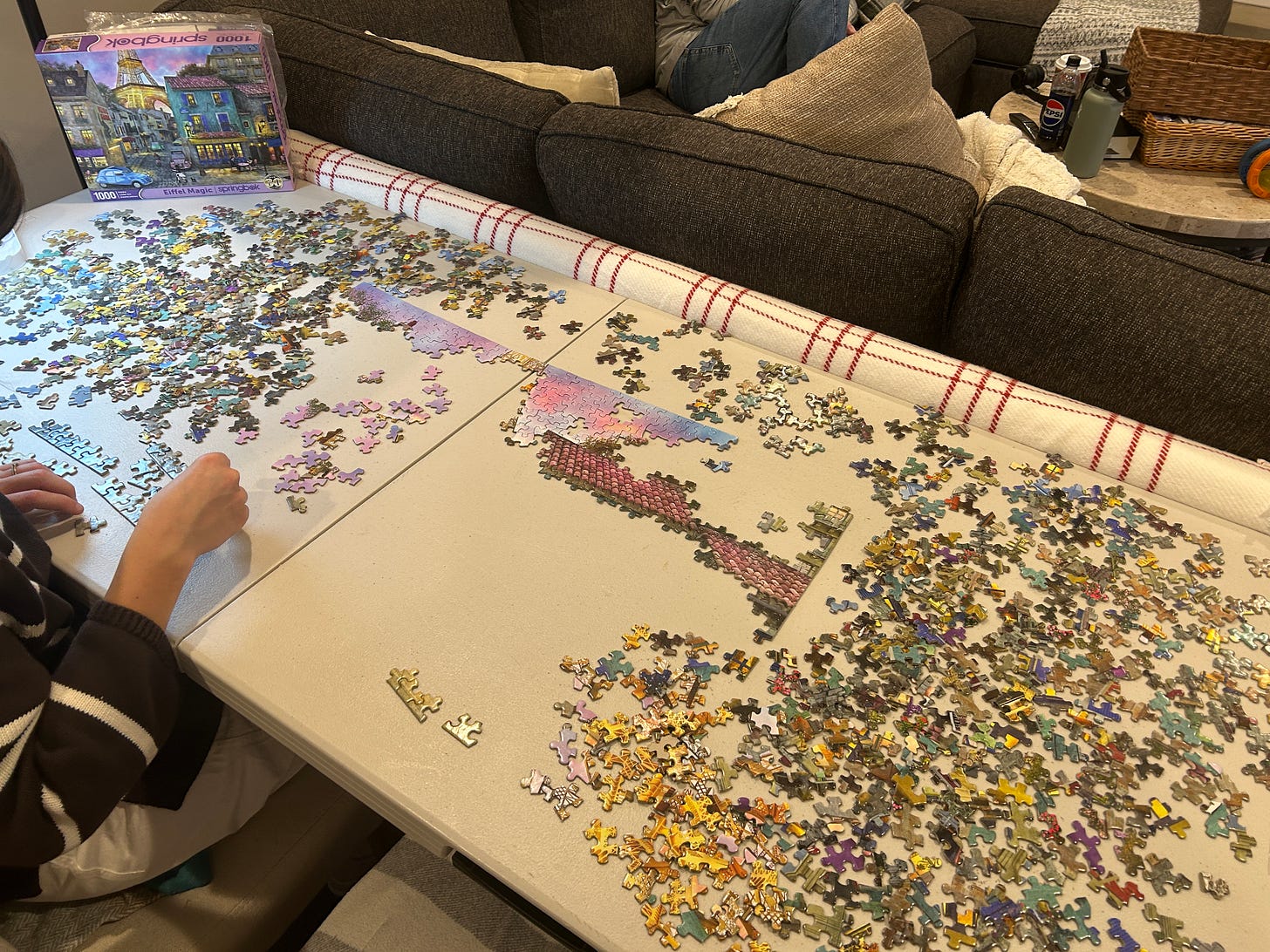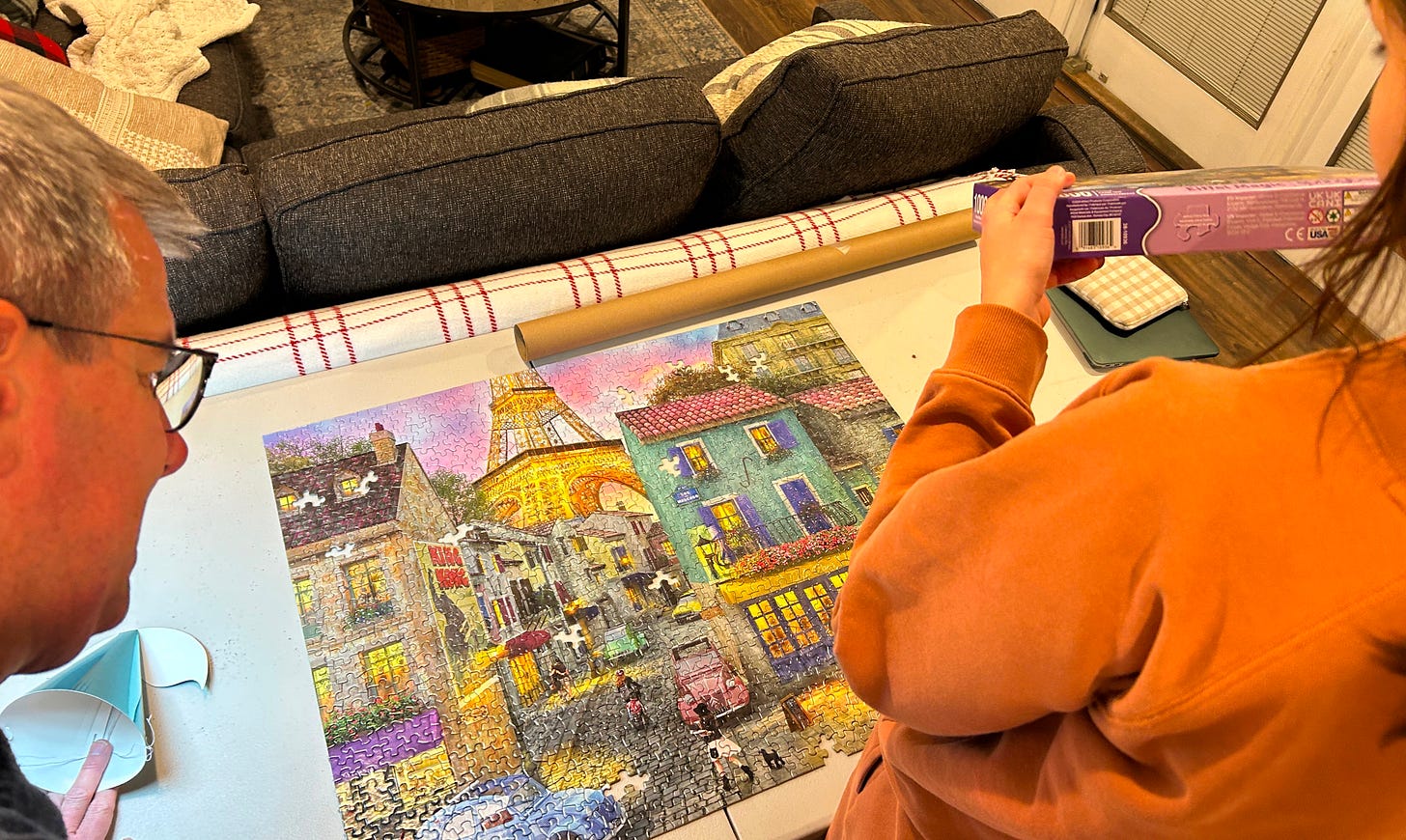Merry Christmas, dear reader!
It’s been some time since I’ve posted. This fall ended up being a bit more chaotic than anticipated, and my weekly Substack writing goal became the first thing to hit the proverbial chopping block.
Over the next several weeks I’ll take some time to reflect on Advent, my favorite time of the year. Today: how a puzzle I worked on over Thanksgiving reminded me of Advent’s first theme: Hope.
If you’re unfamiliar with the concept of Advent, here’s a basic primer. Historically, Christians have divided up the annual calendar into several different chunks. The chunk right before Christmas is called “Advent,” and is usually composed of the four Sundays that precede Christmas. Each Sunday, churches that observe Advent focus on the themes of Hope, Peace, Joy, and Love (in that order), typically lighting one of five colored candles that represent each of these themes. If you’re counting along at home you’d notice that there is one more candle than there are themes (and you’d be right). The 5th candle is the “Christ Candle,” lit on Christmas Eve, the fulfillment of the season of waiting practiced over the previous four weeks.
The whole point of Advent is to engage Christ-followers in a season of expectation and waiting for the coming of Christ. We are meant to put ourselves in the shoes (sandals?) of those who anxiously awaited the one whom the Old Testament prophets spoke of; it is a rehearsal of the narrative of redemption that is meant to engage our whole selves as we pray, read scripture, light candles, eat, and fellowship.
Hope
Courtney and I spent several days over Thanksgiving with my parents and sisters where we participated in a hallowed Busch family holiday tradition: working on a puzzle slowly over several days.
My dad procured a marvelous 1,000 piece-er of the streets of Paris at dusk, dumped onto a card table set up specifically for this affair. Once I began the puzzle, I noticed two thoughts pop into my head.
The first was rather immediate, and it consisted of some self-aware realizing that I don’t like focusing. A puzzle requires me to sit, think, and problem-solve, albeit on a small scale. I’ve noticed that I have had a harder and harder time doing just that recently. I was thankful for the puzzle’s ability to force me to concentrate on a task for more than a few minutes at a time.
The second thought was more abstract. Given that today is the first Sunday of Advent, I was conscious of my excitement over this season that has historically brought me closer to God. It occurred to me that a puzzle is a lot like the picture of reality that ultimately leads us to Christ.
When we first open the box and dump out the pieces, that is much like the lot we receive in life: a hodge-podge of colorful relationships, interests, career opportunities, memories, hopes, experiences, etc. If we tried to assemble these pieces of our reality without some sort of guiding principles or picture of a proper end-result (like the front of the puzzle-box), we would endure much frustration as we attempt to piece each of the oddly shaped cardboard strips together.
And yet, I think many of us go through life this way. We think we have a solid set of guiding principles or values to help us navigate the myriad complexities of family, work, and pleasure, but at best they often consist of ideas such as “let’s assemble the pieces so that the tabs are always on the left, and the slots always on the right.” Not a bad start- it’s consistent. But it likely won’t lead to the beautiful picture that was on the box. Colorful, maybe. Vibrant, perhaps. But not Right. I think we all crave “right.” What is the right way to handle family crisis? What is the right way to go about this conversation with my boss? We carry with us an innate sense that that there is a picture of “reality-as-it-should-be” out there that we do our best to conform our lives to, but often struggle to do so. This occurs because the puzzle-box is lying on the floor face-down rather than sitting front-and-center on the table where we can use it as a reference.
What if we had a puzzle-box that helped us to see how we are to become what we become? It would save us from a lot of anxiety. The good news of Advent is that there is such a thing, and his name is Jesus. We look to Jesus to help us understand what it means to be human. We look to Jesus to know peace and comfort as we sort, arrange, and assemble the pieces of our life. And because we have a guide in him through the power of the Spirit, we have Joy, peace, love, and hope in Him.
That’s not to say that assembling a puzzle isn’t challenging. There’s those funny-shaped pieces I pick up and have no clue where they fit. I often need to turn a piece around several times before I see how it fits into a specific gap. It requires focus and long effort in a the same direction, which can be painful. I often can’t tell how a section of the picture is coming together until I have a critical mass of pieces to help me see how it fits into the ideal image on the puzzle-box. But I have hope as I work at the puzzle that it will one day look like the intended result:
There are a few missing pieces. We didn’t expect the dogs to find puzzle pieces tasty.
But such is life.
My prayer for you on this first Sunday of Advent comes from Romans 15:13 -
May the God of hope fill you with all joy and peace in believing, so that by the power of the Holy Spirit you may abound in hope.




